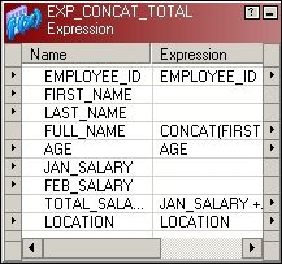Database Reference
In-Depth Information
Active and passive
This classification of transformations is based on the number of records in the input and
output port of the transformation. This classification is not based on the number of ports or
the number of groups.
If the transformation does not change the number of records in its input and output ports, it
is said to be a passive transformation. If the transformation changes the number of records
in the input and output ports of the transformation, it is said to be an active transformation.
Also, if the transformation changes the sequence of records passing through it, it is classed
as an active transformation, as with Union transformations. Let's take an example to under-
stand this classification.
Consider the Expression transformation from the mapping we used in the example of Ex-
pression transformations, where we concatenated
FIRST_NAME
and
LAST_NAME
, as
shown in the following screenshot:
As you can see, the number of input ports is seven and the number of output ports is five.
Say our source contains 10 records in the mapping. When we pass all the records to the
transformation, the total records that will reach the input ports will be 10 and the total re-
cords that will reach the output ports will also be 10, so this makes Expression transforma-
tion passive. We are not concerned about the number of ports in the input and output.
Consider the example of filter transformations that filter out unwanted records, as this
changes the number of records, it is an active transformation.

